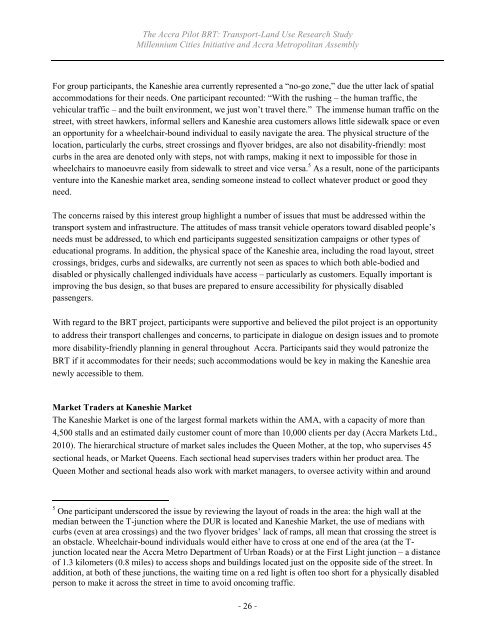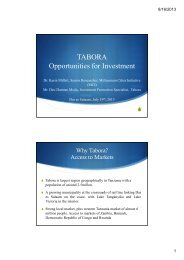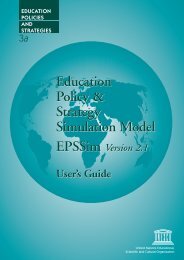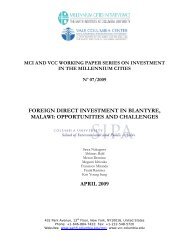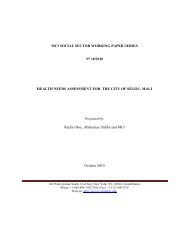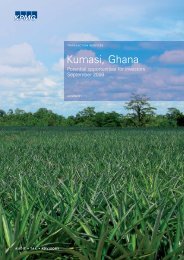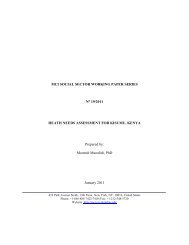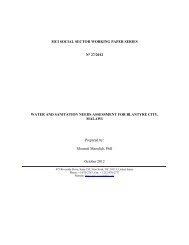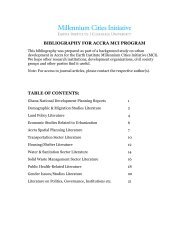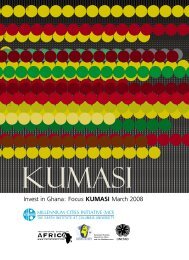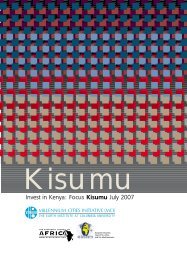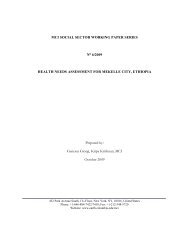Transport-Land Use Research Study - Millennium Cities Initiative ...
Transport-Land Use Research Study - Millennium Cities Initiative ...
Transport-Land Use Research Study - Millennium Cities Initiative ...
Create successful ePaper yourself
Turn your PDF publications into a flip-book with our unique Google optimized e-Paper software.
The Accra Pilot BRT: <strong>Transport</strong>-<strong>Land</strong> <strong>Use</strong> <strong>Research</strong> <strong>Study</strong><br />
<strong>Millennium</strong> <strong>Cities</strong> <strong>Initiative</strong> and Accra Metropolitan Assembly<br />
For group participants, the Kaneshie area currently represented a “no-go zone,” due the utter lack of spatial<br />
accommodations for their needs. One participant recounted: “With the rushing – the human traffic, the<br />
vehicular traffic – and the built environment, we just won‟t travel there.” The immense human traffic on the<br />
street, with street hawkers, informal sellers and Kaneshie area customers allows little sidewalk space or even<br />
an opportunity for a wheelchair-bound individual to easily navigate the area. The physical structure of the<br />
location, particularly the curbs, street crossings and flyover bridges, are also not disability-friendly: most<br />
curbs in the area are denoted only with steps, not with ramps, making it next to impossible for those in<br />
wheelchairs to manoeuvre easily from sidewalk to street and vice versa. 5 As a result, none of the participants<br />
venture into the Kaneshie market area, sending someone instead to collect whatever product or good they<br />
need.<br />
The concerns raised by this interest group highlight a number of issues that must be addressed within the<br />
transport system and infrastructure. The attitudes of mass transit vehicle operators toward disabled people‟s<br />
needs must be addressed, to which end participants suggested sensitization campaigns or other types of<br />
educational programs. In addition, the physical space of the Kaneshie area, including the road layout, street<br />
crossings, bridges, curbs and sidewalks, are currently not seen as spaces to which both able-bodied and<br />
disabled or physically challenged individuals have access – particularly as customers. Equally important is<br />
improving the bus design, so that buses are prepared to ensure accessibility for physically disabled<br />
passengers.<br />
With regard to the BRT project, participants were supportive and believed the pilot project is an opportunity<br />
to address their transport challenges and concerns, to participate in dialogue on design issues and to promote<br />
more disability-friendly planning in general throughout Accra. Participants said they would patronize the<br />
BRT if it accommodates for their needs; such accommodations would be key in making the Kaneshie area<br />
newly accessible to them.<br />
Market Traders at Kaneshie Market<br />
The Kaneshie Market is one of the largest formal markets within the AMA, with a capacity of more than<br />
4,500 stalls and an estimated daily customer count of more than 10,000 clients per day (Accra Markets Ltd.,<br />
2010). The hierarchical structure of market sales includes the Queen Mother, at the top, who supervises 45<br />
sectional heads, or Market Queens. Each sectional head supervises traders within her product area. The<br />
Queen Mother and sectional heads also work with market managers, to oversee activity within and around<br />
5 One participant underscored the issue by reviewing the layout of roads in the area: the high wall at the<br />
median between the T-junction where the DUR is located and Kaneshie Market, the use of medians with<br />
curbs (even at area crossings) and the two flyover bridges‟ lack of ramps, all mean that crossing the street is<br />
an obstacle. Wheelchair-bound individuals would either have to cross at one end of the area (at the Tjunction<br />
located near the Accra Metro Department of Urban Roads) or at the First Light junction – a distance<br />
of 1.3 kilometers (0.8 miles) to access shops and buildings located just on the opposite side of the street. In<br />
addition, at both of these junctions, the waiting time on a red light is often too short for a physically disabled<br />
person to make it across the street in time to avoid oncoming traffic.<br />
- 26 -


